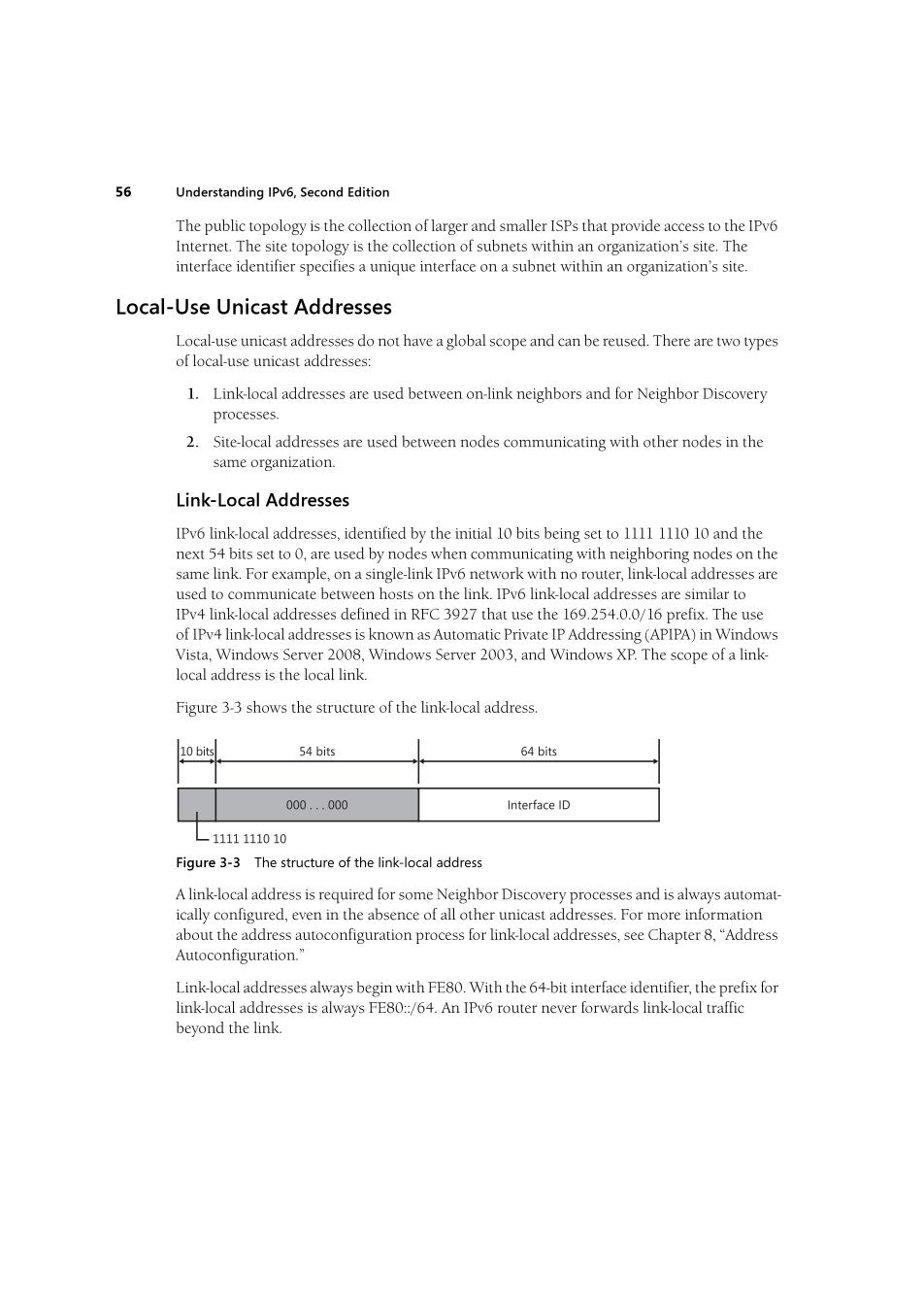正在加载图片...

56 Understanding IPv6,Second Edition The public topology is the collection of larger and smaller ISPs that provide access to the IPv6 Internet.The site topology is the collection of subnets within an organization's site.The interface identifier specifies a unique interface on a subnet within an organization's site. Local-Use Unicast Addresses Local-use unicast addresses do not have a global scope and can be reused.There are two types of local-use unicast addresses: 1.Link-local addresses are used between on-link neighbors and for Neighbor Discovery processes. 2.Site-local addresses are used between nodes communicating with other nodes in the same organization. Link-Local Addresses IPv6 link-local addresses,identified by the initial 10 bits being set to 1111 1110 10 and the next 54 bits set to 0,are used by nodes when communicating with neighboring nodes on the same link.For example,on a single-link IPv6 network with no router,link-local addresses are used to communicate between hosts on the link.IPv6 link-local addresses are similar to IPv4 link-local addresses defined in RFC 3927 that use the 169.254.0.0/16 prefix.The use of IPv4 link-local addresses is known as Automatic Private IP Addressing (APIPA)in Windows Vista,Windows Server 2008,Windows Server 2003,and Windows XP.The scope of a link- local address is the local link Figure 3-3 shows the structure of the link-local address. 10 bits 54 bits 64 bits 000.000 Interface ID -1111111010 Figure 3-3 The structure of the link-local address A link-local address is required for some Neighbor Discovery processes and is always automat- ically configured,even in the absence of all other unicast addresses.For more information about the address autoconfiguration process for link-local addresses,see Chapter 8,"Address Autoconfiguration. Link-local addresses always begin with FE80.With the 64-bit interface identifier,the prefix for link-local addresses is always FE80::/64.An IPv6 router never forwards link-local traffic beyond the link.
!!
!"#
$ !
!% !&
'("( '%) $*'
( +,-$ ' (!.
) ' $$ ! +-./ +% (% 0 $
!!
!"#
$ !
!% !& $
% $ 1
% '% !("'%
2'
!%3$ $
0
% (&'
)%
&
( $
&
$ ' %
4
% (&' !% ' $
% 1
% '% !("'%
2'
!%3$ $
0 5 67
8 9! '
:$ %
'$ '))($$$ )! %! '. ' "
!
'
$ ! '%) '%
($)0 ( '( 1! #$ !&
! '
:$ %
'$ '))($$$; <= 9
%>:
! '
'))($$$ '( $)
1% !%:
%> %
"
!($ '%) &!( ?
"
!( @
$ !.(# (! $$$0 A= ,
:
! '
'))($$$ '( $)
1% %!)$ !**%
'
%" 1
! ( %!)$
% $'* !("'%
2'
!%0 5
B75 6 8 +-./
%>:
! '
'))($$$C
)%
&
)
#
%
'
DE
$
%" $ ! DDDD DDDE DE '%) %F GH
$ $ ! EC '( $)
# %!)$ 1% !**%
'
%" 1
%
"
!(
%" %!)$ !% $'*
%>0 I!( F'*
C !% ' $
%"
:
%> +-./ % 1!(> 1
%! (! (C
%>:
! '
'))($$$ '( $) ! !**%
'
1% !$ $ !%
%>0 +-./
%>:
! '
'))($$$ '( $
*
'( ! +-.H
%>:
! '
'))($$$ )&
%)
% JIK LMNO ' $ D/M0NGH0E0EPD/ (&
F0 $ !&+-.H
%>:
! '
'))($$$
$ >%!1% '$ Q !*'
-(
.' +- Q))($$
%" RQ-+-QS
% T
%)!1$ U
$ 'C T
%)!1$ ,(.( NEEVC T
%)!1$ ,(.( NEELC '%) T
%)!1$ W-0 $ ! !& '
%>:
! '
'))($$
$
! '
%>0 I
"( L:L $!1$ $ ( ( !&
%>:
! '
'))($$0 X
Y Z7Z [\] ^_`ab_a`] cd _\] efghiecbje jkk`]^^ Q
%>:
! '
'))($$
$ (4
() &!( $!* ?
"
!( @
$ !.(# (! $$$ '%)
$ '
1'#$ ' !*' :
'
# !%&
"()C .%
% '
$% !& '
! ( %
'$ '))($$$0 I!( *!(
%&!(*'
!% '
! '))($$ ' ! !%&
"('
!% (! $$ &!(
%>:
! '
'))($$$C $ K' ( VC lQ))($$ Q ! !%&
"('
!%0m 9
%>:
! '
'))($$$ '
1'#$
"
% 1
InVE0 T
/H:
% (&'
)%
&
(C (&
F &!(
%>:
! '
'))($$$
$ '
1'#$ InVE;;P/H0 Q% +-./ (! ( %.( &!(1'()$
%>:
! '
('&&
#!%)
%>0 op qrst uv qrst wv qrst ppp ppp xysz{|}~z x oooo ooop op����